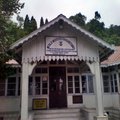Netaji Museum and Centre for Studies in Himalayan Languages, Society and Culture, Kurseong, Giddhapahar

This house in Giddhapahar, Kurseong: is a historic house, associated with the sacred memory of the two illustrious sons of India – Sarat Chandra Bose and Netaji Subhas Chandra Bose. Available records indicate this in 1922 Sarat Chandra Bose purchased the house from one Mr. Rowley Lascelles Ward, in 1925 Deshbandhu Chittranjan Das and his wife Basanti Devi spent a day with Sarat Chandra Bose in this house, incidentally, this memorable visit took place a couple of weeks before Deshbandhu’s death in Darjeeling on 16th June 1925. Between 1933 and 1935 Sarat Chandra Bose was interned in this house for two years.
Sarat Chandra and his family used to stay in this house frequently after his release from the prison in 1945. Even in the 1950s Bibhabati Devi, wife of Sarat Chandra, spent their holidays in Giddapahar along with her family members, the last occasion being in 1954. Thereafter, for more than three decades the house remained unused, neglected and unattended.
Netaji himself was interned in Giddhapahar for seven months in October 1936. He again spent a few days in this house in October 1937. One interesting part of this stay at Giddhapahar was the communications he had with Emilie Schenkl. Out of the twenty six letters that Subhas Chandra Bose wrote from Giddhapahar in 1936, eleven were written to Emilie. During this stay Netaji also received ten letters from Emilie. These correspondences between Subhas Chandra and Emilie Schenkl testify to their deep personal relationship. Moreover, during his stay at Giddhapahar Subhas Chandra corresponded with Rabindranath Tagore and Jawaharlal Nehru on the controversy that had then developed about the song Bande Mataram.

From the photographs during his stay at Giddhapahar one could visualise Subhas sitting on the armchair in the lounge of this house, looking up towards the Himalayas for spiritual guidance, or pacing restlessly in its lawns and musing on the plains for the epic struggle with the raj, which was soon to follow. In fact, his internment in this house at a crucial stage in his political career enabled him the opportunity to reflect on his past and plan for the future. With its proximity to the mountains, the house in its idyllic situation elevated his spirit. Once in his boyhood, Subhas said: “the happiest day in my life will be when i shall become independent and a still happier one when I shall go to Darjeeling”.
The Museum and Centre was set up in the house of Sarat Chandra Bose at Giddhapahar, Kurseong under the aegis of NIAS. In 1996 the Department of Higher Education, Government of West Bengal, initiated the process of acquiring the house. Subsequently, the Government of West Bengal restored and renovated the house and handed it to Netaji Institute For Asian Studies, Kolkata. Under the aegis of Netaji Institute For Asian Studies the historic house was converted into Netaji Museum and Centre For Studies in Himalayan Languages, Society and Culture, which was formally inaugurated on 23 April 2000.
Test page for Kurseong center
 Netaji Institute For Asian Studies
Netaji Institute For Asian Studies Netaji Institute For Asian Studies
Netaji Institute For Asian Studies